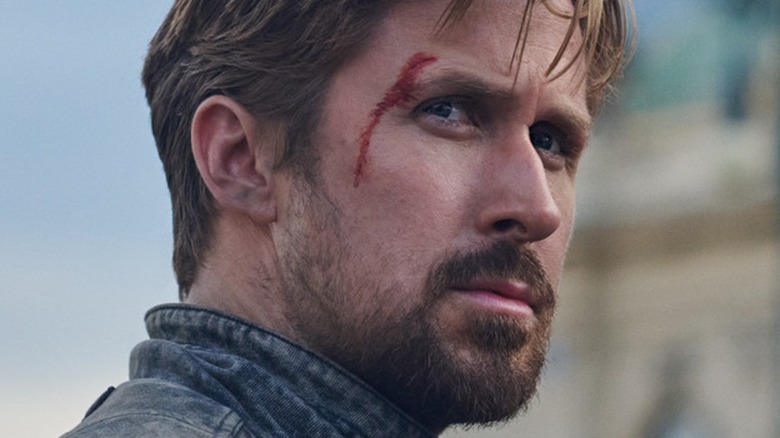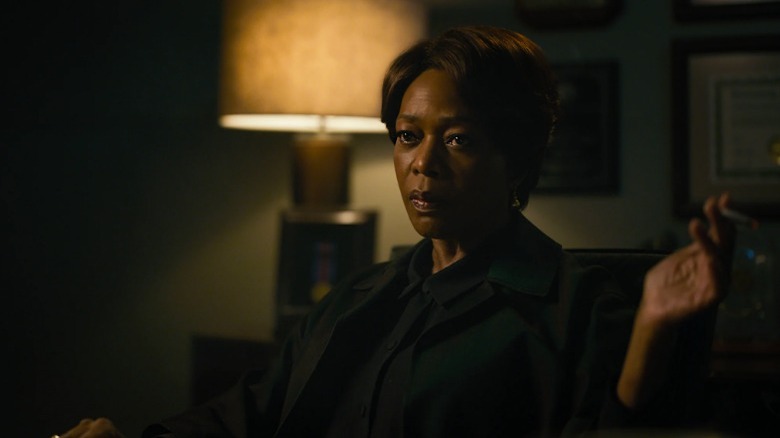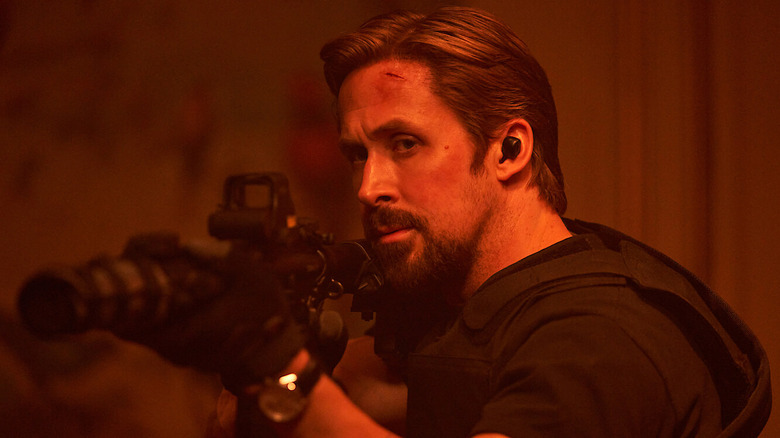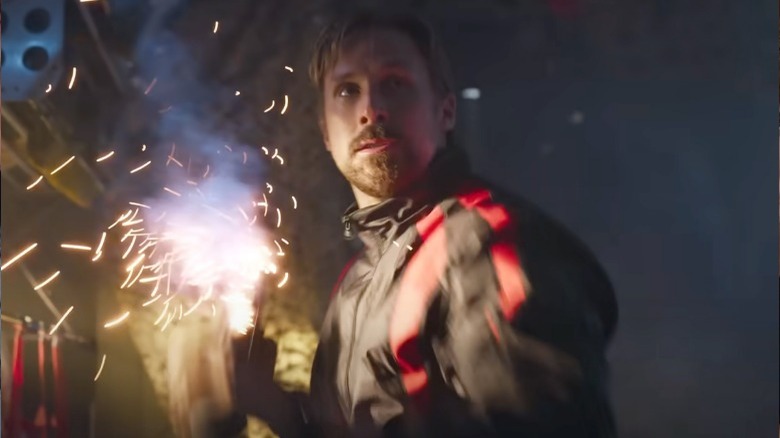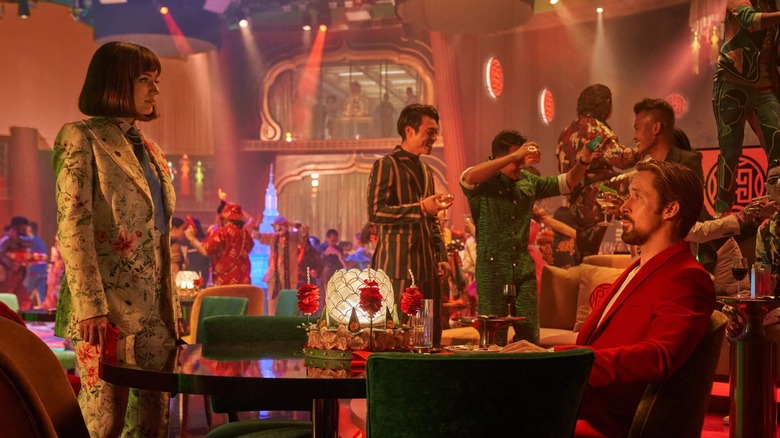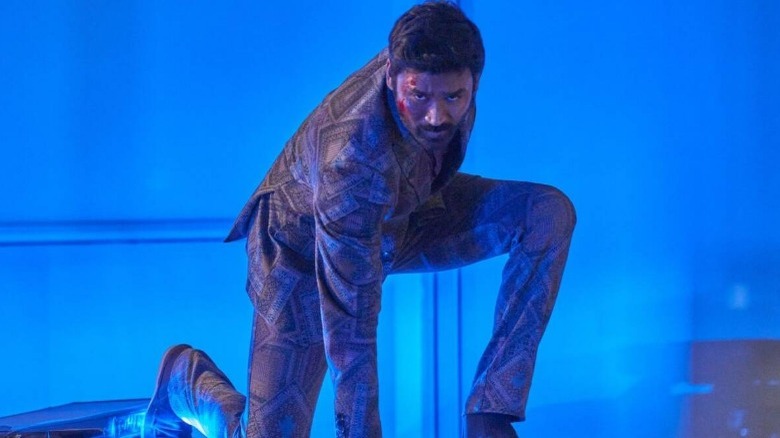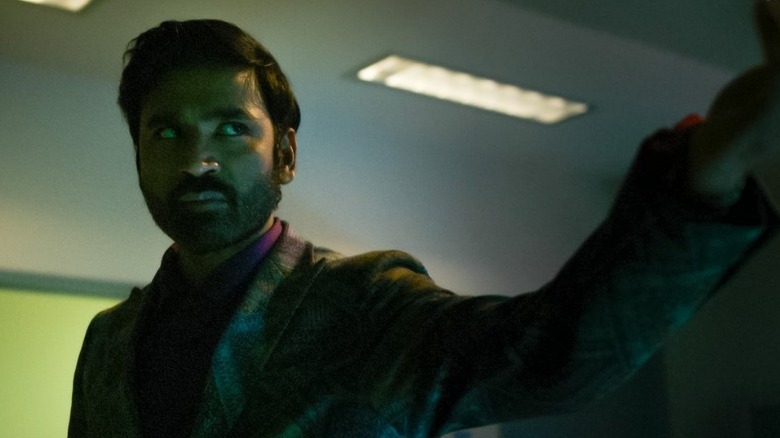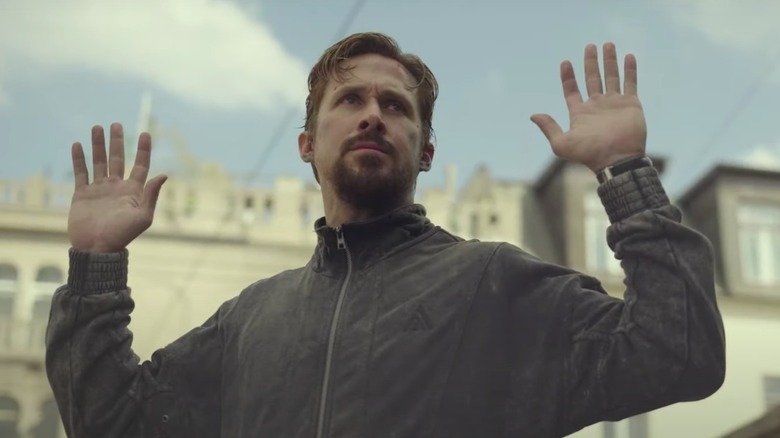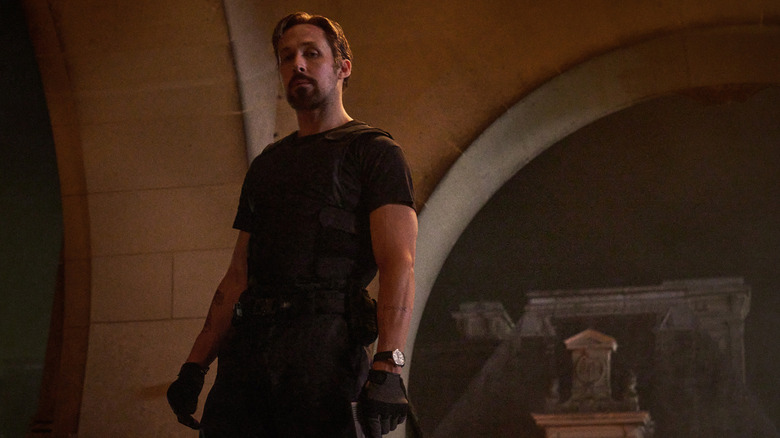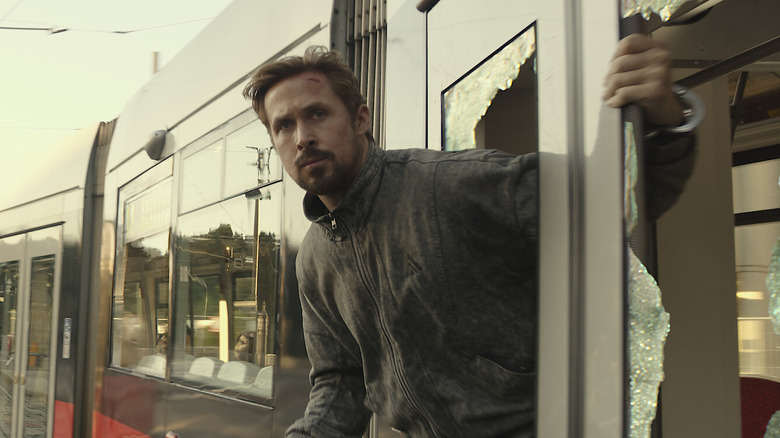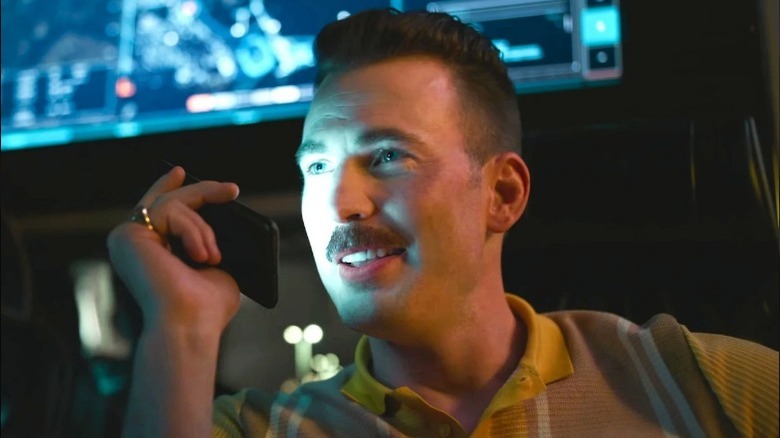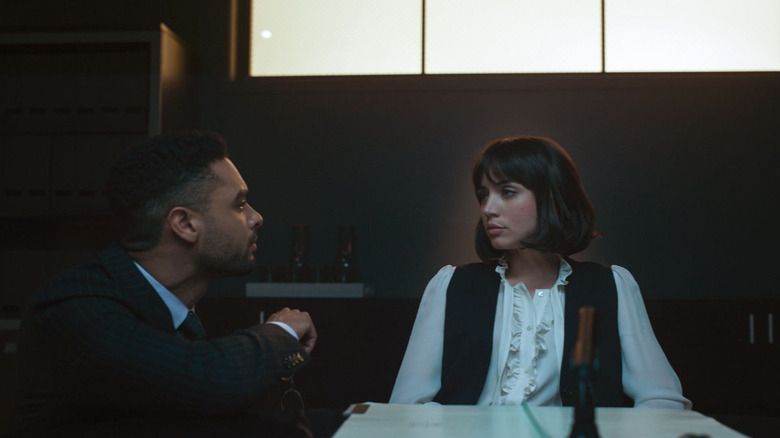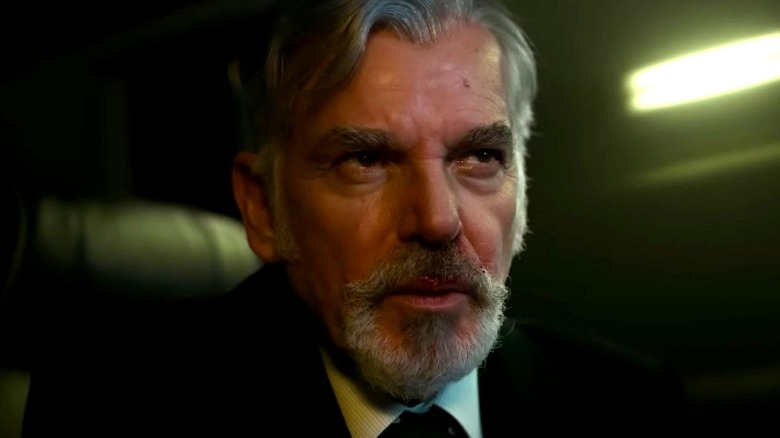The 6 Best And 6 Worst Moments In The Gray Man
Major spoilers for "The Gray Man" follow.
In the run-up to the release of "The Gray Man," much of the buzz was about its budget. With a price tag of $200 million, it's one of the most expensive Netflix movies of all time. Watching the final product, there's no question that a lot of that cash ended up on the screen. Directors Anthony and Joe Russo take viewers to all sorts of glamorous locales, including Prague and Bangkok, while the cast list is packed with famous — and costly — names like Ryan Gosling, Chris Evans, and Billy Bob Thornton.
However, all the money in the world cannot guarantee a masterpiece. "The Gray Man" has scope to spare, but it's a highly imperfect action blockbuster. The fight choreography and a committed performance from Chris Evans the ultimate slimeball are both top-notch, but the editing and overall story leave much to be desired.
In its most rewarding scenes, "The Gray Man" provides spectacles as impressive as its star-studded cast. Unfortunately, other moments will leave viewers frustrated. Alternating between these creative highs and lows results in a messy feature whose sporadic charms will make you yearn for more consistency. With the film now available to watch on Netflix, it's the perfect time to delve into the best and worst moments of "The Gray Man."
Best: Cahill's surprise self-sacrifice
Alfre Woodard doesn't get a lot to do in "The Gray Man." Playing Margaret Cahill, the former head of the CIA's London outpost, the audience only sees her once in a flashback before Court Gentry (Ryan Gosling) and Dani Miranda (Ana de Armas) visit her in Prague to get some much-needed answers. However, while her screen time is limited, at least her character gets to go out with a bang — literally. Introduced in the modern world clinging to an oxygen tank, death lurks around Cahill for the majority of her time on screen. However, when an army of mercenaries breaks into her home, she's allowed to confront death on her terms.
Luring all these men into her kitchen, Cahill sits calmly in a chair, then flicks on her trusty lighter. Suddenly, one of the mercenaries realizes that her stove is on, and that they've just walked into a trap. She may be on death's door, but Cahill can still pack a wallop, as evidenced by the massive explosion her stove produces. More Woodard would always be appreciated, especially in a film like "The Gray Man," which barely uses her, but at least she gets one of the most cheer-worthy moments of the entire movie.
Worst: Gentry and Claire bond in flashback
Midway through "The Gray Man," a flashback raises the personal stakes for Gentry. Shortly after Claire (Julia Butters), the granddaughter of Donald Fitzroy (Billy Bob Thornton), is kidnapped, we realize that she and Gentry share a special bond. Gentry was once hired to watch over Claire, who has a heart condition, for a weekend; the duo bonded over music, and Gentry saved Claire's life during a medical emergency. This is supposed to reveal new depths to "The Gray Man" protagonist, while lending an extra sense of urgency to Claire's plight.
However, much like a similar flashback to Gentry's childhood, this moment arrives way too late into the movie. This should be a prologue, not a mid-movie afterthought. In addition, a single moment of connection doesn't feel like enough to establish such a close connection between the duo. Finally, giving a tough hitman a kid who melts his heart is an overdone trope in modern pop culture. Projects like "The Mandalorian" and "Lone Wolf and Cub" have already done this schtick, and they do it better. This flashback is meant to inject the whole movie with extra emotional resonance, but this glimpse into the past leaves much to be desired.
Best: A fight against fireworks
"The Gray Man" establishes Gentry's skills as a mercenary right away. After a 2003-set prologue, the story shifts to the modern day, where Gentry, using the alias Sierra Six, has been tasked with taking out a target during a celebration in Bangkok. Gentry eliminates an assortment of henchmen with ease, but his primary prey eludes him. So, our protagonist follows his quarry outside and onto a small pocket of land, where a bunch of fireworks are being set off. The duo fight as explosives are set off around them, with one of those blasts detonating right in Gentry's opponent's face.
The fight choreography here is nothing special. However, the draw isn't the fists being thrown, but rather the backdrop. Having this skirmish set against a barrage of fireworks lends a distinct personality to this set piece. Bright hues occasionally pepper the frame, reminding viewers of the normal world, the one that Gentry is so detached from. It also lends an extra sense of danger to every one of their moves, as one never knows where or when a firework will go off next. The fight isn't an all-time great action sequence, but it shows off some visual flair while effectively conveying the ruthless efficiency of the film's protagonist.
Worst: The loaded gun exchange
Following a lengthy chase through a hospital, Miranda has Avik San (Dhanush) in her sights. However, when she pulls the trigger on a gun that Gentry just handed her, she finds out that there aren't any bullets inside, leaving her to watch helplessly as San speeds away. Miranda confronts Gentry about his decision, producing a comedic exchange between the two that's largely centered on Gentry's explanation that "you never toss someone a loaded weapon."
This extended bit of dialogue is a strange way to finish off this sequence. For one, Avik San has escaped with the film's primary MacGuffin, an incriminating flash drive, in hand. This should inspire a moment of sorrow, not open the floodgates for quips. For another, the banter between Miranda and Gentry goes on for an uncomfortable length of time. Comedy is all about pacing, and without a proper sense of timing, this exchange is robbed of its potential laughs. It doesn't even add extra dimensions to Miranda and Gentry's relationship, since the duo was already at odds with one another. On paper, this may have seemed like comedy gold, but the "loaded gun" exchange is one of the more uncomfortable comedic misfires in "The Gray Man."
Best: A hospital fight
Gentry and Miranda already face tons of obstacles while trying to break into a hospital, and their problems are exacerbated tenfold once Avik San arrives to fight them for that pesky flash drive. The scene that follows immediately differentiates itself from other "The Gray Man" skirmishes by simply being a two-on-one duel, rather than a mano-a-mano showdown. Watching Gentry and Miranda work together to fight back against a new adversary is surprisingly fun.
Arguably even more enjoyable, though, is watching Dhanush's stellar handling of the fight choreography. Even when his character is outmatched, Dhanush portrays San as someone who's light enough on his feet to easily handle multiple opponents at a time. This allows the actor to show off his physicality and screen presence. Informed by these qualities, San quickly becomes one of the most intriguing villains "The Gray Man" has to offer. Granted, this fight scene ends on a bit of a whimper, with San simply speeding away on a motorcycle, but the hospital battle is still a winner, and establishes San as a scene-stealing supporting character.
Worst: The awkward end to San's subplot
While Gentry gets the lion's share of action beats in the climax of "The Gray Man," Miranda isn't left entirely on the sidelines. During the movie's home stretch, she fires off rockets and gets a hand-to-hand rematch with Avik San. Duking it out in the tattered remains of Lloyd Hansen's (Chris Evans) control center, the sequence's dim lighting undercuts some of its excitement, but it's still a lot of fun to see the two characters, especially San, engaging in a well-choreographed fight again.
However, the scuffle comes to an awkward close when San abruptly reveals that he won't fight with Miranda anymore and hands her the flash drive. As it turns out, Hansen and his cohort "are not honorable people." This pays off an earlier line, which indicated that San was disturbed by the news that Hansen was holding a child hostage. It makes sense for San to have a change of heart, but why now? Why did he do some more punching first? The preceding fight scene is rendered pointless, especially since nothing during this showdown reminded San of his moral objections. Adding insult to injury, after releasing the flash drive, San just walks out of the room, a clumsy and abrupt conclusion that accentuates the awkwardness of this entire sequence.
Best: A sudden trapdoor
"The Gray Man" is not a movie drenched in realism. However, in terms of grit, it's more in line with your average "Bourne" installment or Daniel Craig's James Bond movies than a sci-fi flick. "The Gray Man" features a grim tone, and usually has no time for extreme forms of silliness, although that doesn't mean that there aren't occasional forays into the ridiculous. The best example of what happens when "The Gray Man" lets its hair down comes when Gentry attempts to get a passport picture taken; in the middle of the process, a seemingly helpful photographer pushes a button, and the ground beneath Gentry vanishes.
Landing on hard pavement, Gentry realizes that he's fallen through a secret trapdoor. It feels like something straight out of an episode of "Scooby-Doo," not a movie that channels the vibe of "Patriot Games." Departing so heavily from the film's established tone isn't a bad thing, though; secret trapdoors are always a welcome presence. Granted, this moment of preposterousness would've even been better if Gentry didn't utter the intrusive meta-comment, "Secret trapdoor —didn't see that coming," but at least "The Gray Man" takes a break from the seriousness for a moment to indulge in a bit of welcome absurdity.
Worst: The flashback to Gentry's childhood trauma
As Gentry cleans himself up in preparation for his passport photo, the audience sees a distinct circular wound on one of his arms. Suddenly, we're thrust into the past, where we learn that this injury occurred when Gentry's father (Shea Whigham) burned his son with a cigarette lighter in a warped attempt to toughen up the boy. As an adult, the physical and emotional scars created by that adolescent torment continue to influence Gentry's decisions, particularly his choice to be a surrogate father figure to Claire.
There's no problem with offering a peek into what makes Gentry who he is, but "The Gray Man" needed to deploy this flashback in a better place in the story. Including it during such a propulsive stretch of the narrative makes it feel like a distraction. Even more problematic, up until this point "The Gray Man" has gleefully dished out violence. Conceptually, that's not a bad thing, but it does make it hard to suddenly reckon with the lasting psychological consequences of physical abuse. There's a reason why the "John Wick" movies don't try to cover the same territory as "Honey Boy." While it's intended to shed some light on Gentry's troubled psyche, this glimpse into the past just makes "The Gray Man" needlessly convoluted.
Best: The Prague chase
The best action sequence in "The Gray Man" comes in the middle of the film, when Gentry has to evade endless waves of trigger-happy mercenaries in Prague. What makes this stretch especially enjoyable is the way it continually escalates the stakes. The scene starts with Gentry handcuffed to a bench by the police; he's still chained up when the villainous forces arrive. Gentry has to use his wits to get out of his cuffs — thanks to the confined scope, this actually feels quite intense. Each bullet that ricochets off a nearby object serves as a reminder that Gentry only has a little time left.
Even once he's free, Gentry isn't out of the woods. A chase scene begins as Gentry boards a nearby train. Not only is he hunted by a handful of people aboard, but heavily armed cars outside hurl endless rounds of ammo at him. The ludicrousness ramps up even further as Miranda joins the fight in an automobile, and then the train goes off the rails and collides with a building. Unfortunately, all this mayhem sets a high bar for the rest of the film that the later action scenes can't clear. Even so, the Prague chase impresses by constantly finding new ways to become more and more outlandish.
Worst: Fitzroy is tortured
One notable downside about "The Gray Man" receiving a PG-13 rating is that Lloyd Hansen's supposed ruthlessness is rarely seen. We constantly hear characters talk about what a violent and uncontrollable man Hansen is, but viewers don't actually witness his deplorable behavior. These limitations become especially apparent when Hansen wants to get vital information out of Donald Fitzroy. Fitzroy won't just blurt out classified intel, which means that Hansen has to get his hands dirty.
To show that he means business, Hansen grabs Fitzroy by the ears without warning and shakes his head around. After releasing the man, Hansen reveals that he just made up that torture technique. This is meant to show how Hansen can come up with intimidating tactics on the spot. However, the sight of Chris Evans shaking Billy Bob Thornton is unintentionally comical. This is followed up by Hansen cutting off some of Fitzroy's fingernails, although the audience only sees Fitzroy's reaction and Hansen plopping fingernails on a nearby table. Restrictions can sometimes inspire great creativity. In "The Gray Man," though, the limitations of a PG-13 rating dull the edges of its supposedly sadistic villain, robbing this scene of much of its impact.
Best: The bad guys technically win
As "The Gray Man" wraps up its story, the screenplay takes one of its most intriguing detours. After foiling Hansen's evil plans, Gentry has not been redeemed in the eyes of the CIA, and he's sent to a secure prison cell. Meanwhile, Miranda and antagonistic CIA officials Suzanne Brewer (Jessica Henwick) and Denny Carmichael (Regé-Jean Page) are dressed down by their superiors (one of whom is played by Joe Russo). The verdict from these higher-ups is that there won't be any consequences for the trio. For Miranda, that's understandable — she helped save the world. However, it's an unexpected outcome for the other two characters, particularly Carmichael, who has made shady deals with nefarious figures all across the globe.
At this moment, "The Gray Man" becomes a little introspective, showing how government corruption is often swept under the rug in America. After all, this is a country where Richard Nixon was pardoned and the people in charge of torturing suspects after 9/11 received no punishments. Our justice system lets these kinds of figures off the hook all the time, and "The Gray Man" makes sure that Carmichael and Brewer suffer zero consequences for working with Lloyd Hansen. Granted, "The Gray Man" doesn't use this bleak worldview to say anything super substantial, but it's still a welcome dash of realism and commentary in an otherwise standard ending.
Worst: The digital de-aging
"The Gray Man" opens with a flashback to the year 2003, when Donald Fitzroy met Court Gentry in prison. It's an important sequence that shows the incarcerated criminal getting a second chance at life while also establishing the connection between Fitzroy and Gentry. There are lots of critical story details here to digest, but it's unlikely that people will be focusing on those. They'll be too distracted by the digital effects used to de-age Billy Bob Thornton by two decades.
Directors Anthony and Joe Russo have plenty of experience with deaging effects, having utilized them in films like "Captain America: Civil War" and "Avengers: Endgame." However, that prior experience didn't seem to help with "The Gray Man." The younger Fitzroy looks rigid and jarringly plastic, and doesn't convey the emotions necessary to make this sequence work. Even more bizarre, this isn't what Billy Bob Thornton looked like in 2003. There's plenty of footage of Thornton from that era, and the discrepancy takes the viewer out of the film entirely.
